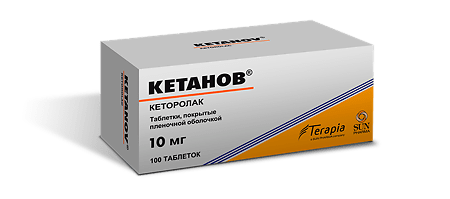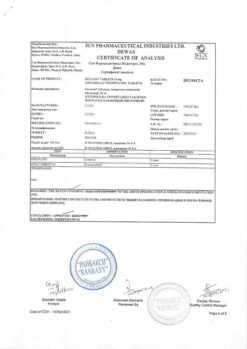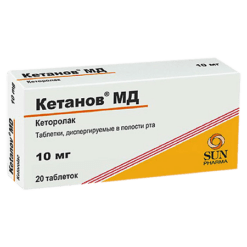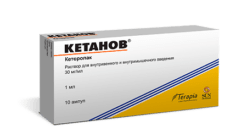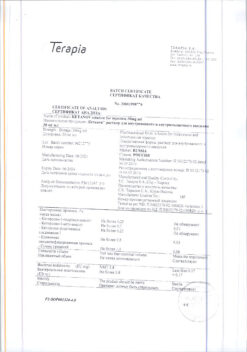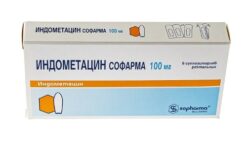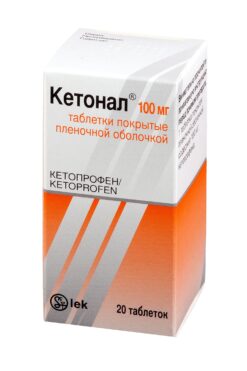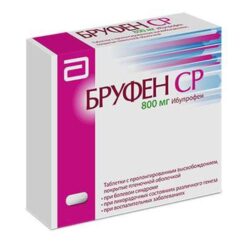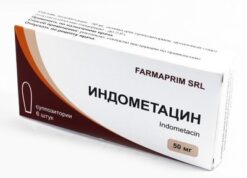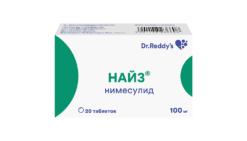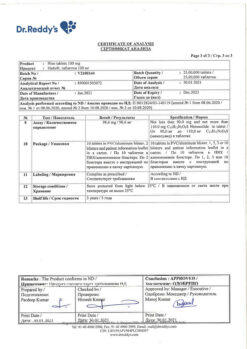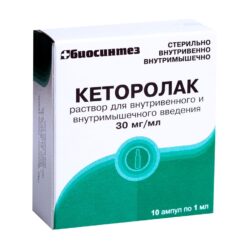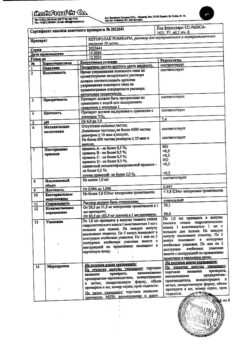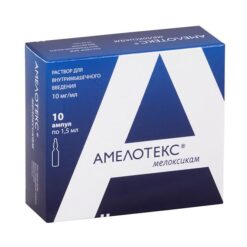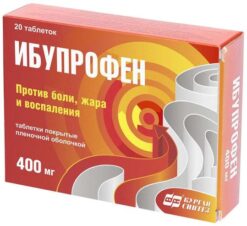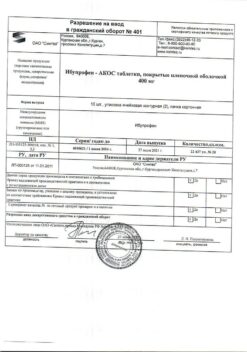No products in the cart.
Ketanov, 10 mg 100 pcs
€7.13 €6.24
Out of stock
(E-mail when Stock is available)
Description
Pharmacotherapeutic group:
Non-steroidal anti-inflammatory drug (NSAID).
ATX code: M01AB15
Pharmacological action:
Pharmacodynamics
Ketorolac has a pronounced analgesic effect, also has anti-inflammatory and moderate antipyretic effects.
The mechanism of action is related to non-selective inhibition of activity of cyclooxygenase-1 (COX-1) and cyclooxygenase-2 (COX-2) enzymes, mainly in peripheral tissues, with following inhibition of prostaglandin biosynthesis – modulators of pain sensitivity, thermoregulation and inflammation. Ketorolac is a racemic mixture of [-]S and [+]R enantiomers, and the analgesic effect is due to the [-]S form.
The drug does not affect the opioid receptors, does not depress respiration, does not cause addiction and has no sedative and anxiolytic action. Its analgesic effect is comparable with that of morphine; it is considerably superior to other non-steroidal anti-inflammatory drugs.
After oral administration, the onset of analgesic effect is noted after 1 hour, the maximum effect is reached after 1 -2 hours.
Pharmacokinetics
After oral administration, ketorolac is well absorbed in the gastrointestinal tract – maximum concentration (Cmax) in blood plasma (0.7-1.1 mcg/ml) is reached 40 min after an empty stomach dose of 10 mg. Fat-rich food decreases the maximum blood concentration of the drug and delays its achievement by 1 hour. 99% of the drug is bound to plasma proteins, and in case of hypoalbuminemia the amount of free substance in blood increases. Bioavailability is 80-100%). Time of reaching equilibrium concentration (Css) when administered orally is 24 hours when administered 4 times a day (higher than subtherapeutic) and is 0.39-0.79 mcg/ml after 10 mg oral administration.
The volume of distribution is 0.15-0.33 l/kg. In patients with renal insufficiency the distribution volume of the drug may increase by 2 times and the distribution volume of its R-enantiomer by 20%.
Transfers to breast milk: after maternal administration of the first and second doses of Ketorolac 10 mg, the Cmax in milk is reached after 2 hours and is 7.3 ng/ml and 7.9 g/l, respectively.
More than 50% of the administered dose is metabolized in the liver to form pharmacologically inactive metabolites. The main metabolites are glucuronides, which are excreted by the kidneys, and p-hydroxyketorolac. It is excreted 91% by the kidneys, 6% – through the intestine.
The elimination half-life (T1/2) in patients with normal renal function is 2.4-9 h after oral administration of 10 mg. The T1/2 is longer in elderly patients and shorter in younger patients. Liver function has no effect on the T1/2. In patients with impaired renal function with plasma creatinine concentrations of 19-50 mg/l (168-442 μmol/l)
The T1/2 is 10.3-10.8 h, with more severe renal impairment more than 13.6 h.
The total clearance is 0.025 l/kg/h when administered orally at 10 mg; in renal failure with plasma creatinine concentrations of 19-50 mg/l when administered orally at 10 mg-0.016 l/kg/h.
It is not excreted by hemodialysis.
Indications
Indications
Pain syndrome of moderate and severe intensity of various origins (including in the postoperative period, with cancer, etc.)
Pharmacological effect
Pharmacological effect
Pharmacotherapeutic group:
non-steroidal anti-inflammatory drug (NSAID).
ATX code: М01АВ15
Pharmacological action:
Pharmacodynamics
Ketorolac has a pronounced analgesic effect and also has anti-inflammatory and moderate antipyretic effects.
The mechanism of action is associated with non-selective inhibition of the activity of the enzyme cyclooxygenase-1 (COX-1) and cyclooxygenase-2 (COX-2), mainly in peripheral tissues, resulting in inhibition of prostaglandin biosynthase – modulators of pain sensitivity, thermoregulation and inflammation. Ketorolac is a racemic mixture of [-]S and [+]R enantiomers, and the analgesic effect is due to the [-]S form.
The drug does not affect opioid receptors, does not depress respiration, does not cause drug dependence, and does not have a sedative or anxiolytic effect. The strength of the analgesic effect is comparable to morphine, significantly superior to other non-steroidal anti-inflammatory drugs.
After oral administration, the onset of analgesic effect is observed after 1 hour, the maximum effect is achieved after 1-2 hours.
Pharmacokinetics
After oral administration, ketorolac is well absorbed from the gastrointestinal tract – the maximum concentration (Cmax) in the blood plasma (0.7-1.1 mcg/ml) is achieved 40 minutes after taking a dose of 10 mg on an empty stomach. Food rich in fat reduces the maximum concentration of the drug in the blood and delays its achievement by 1 hour. 99% of the drug binds to blood plasma proteins, and with hypoalbuminemia the amount of free substance in the blood increases. Bioavailability – 80-100%). The time to reach equilibrium concentration (Css) with oral administration is 24 hours when administered 4 times a day (above subtherapeutic) and after oral administration of 10 mg is 0.39-0.79 mcg/ml.
The volume of distribution is 0.15-0.33 l/kg. In patients with renal failure, the volume of distribution of the drug may increase by 2 times, and the volume of distribution of its R-enantiomer by 20%.
Penetrates into breast milk: after the mother takes the first and second doses of ketorolac, 10 mg Cmax in milk is reached after 2 hours and is 7.3 ng/ml and 7.9 g/l, respectively.
More than 50% of the administered dose is metabolized in the liver to form pharmacologically inactive metabolites. The main metabolites are glucuronides, which are excreted by the kidneys, and p-hydroxyketorolac. It is excreted 91% by the kidneys, 6% through the intestines.
The half-life (T1/2) in patients with normal renal function is 2.4-9 hours after oral administration of 10 mg. T1/2 lengthens in elderly patients and shortens in young ones. Liver function has no effect on T1/2. In patients with impaired renal function with a plasma creatinine concentration of 19-50 mg/l (168-442 µmol/l)
T1/2 is 10.3-10.8 hours, with more severe renal failure – more than 13.6 hours.
The total clearance when taken orally is 10 mg – 0.025 l/kg/h; in case of renal failure with a plasma creatinine concentration of 19-50 mg/l when taken orally 10 mg-0.016 l/kg/h.
Not excreted during hemodialysis.
Special instructions
Special instructions
Ketorolac inhibits platelet aggregation and increases blood clotting time. The effect on platelet aggregation ceases after 24-48 hours.
Hypovolemia increases the risk of developing adverse reactions from the kidneys.
If necessary, can be prescribed in combination with narcotic analgesics.
Ketanov® is not recommended for use as a premedication or maintenance anesthesia.
Cases of fluid retention, arterial hypertension and edema have been reported with the use of ketorolac. Caution must be exercised when prescribing to patients with heart failure and arterial hypertension.
Concomitant use with other nonsteroidal anti-inflammatory drugs can lead to disorders such as decompensation of heart failure and increased blood pressure. Patients with bleeding disorders are prescribed the drug only with constant monitoring of the platelet count, which is especially important in the postoperative period, when careful monitoring of hemostasis is required.
According to clinical studies, the use of certain non-steroidal anti-inflammatory drugs in high doses may lead to an increased risk of arterial thrombotic complications (for example, myocardial infarction, stroke). Although such complications have not been reported with ketorolac, existing data are insufficient to exclude the risk of such complications. The risk of adverse reactions increases with lengthening the treatment period and increasing the oral dose to more than 40 mg/day.
To reduce the risk of developing NSAID gastropathy, it is recommended to use antacids, misoprostol, as well as drugs that reduce gastric secretion (histamine H2 receptor blockers, proton pump inhibitors).
The influence of a medicinal product for medical use on the ability to drive vehicles and machinery
During the treatment period, side effects from the central nervous system (drowsiness, dizziness, headache) may develop, which reduces the speed of mental and motor reactions and therefore it is necessary to refrain from driving vehicles and engaging in other potentially hazardous activities that require increased concentration and speed of psychomotor reactions.
Active ingredient
Active ingredient
Ketorolac
Composition
Composition
One film-coated tablet contains:
Active substance: ketorolac trometamol -10.00 mg.
Excipients:
corn starch – 44.76 mg, microcrystalline cellulose – 122.41 mg, colloidal silicon dioxide – 1.83 mg, magnesium stearate – 1.00 mg.
Film casing:
hypromellose – 2.91 mg, macrogol-400 – 0.68 mg, purified talc – 0.16 mg, titanium dioxide – 1.25 mg.
Pregnancy
Pregnancy
The safety of this drug during pregnancy has not been established. Use of drugs during the third trimester of pregnancy. disrupting the synthesis of prostaglandins, can cause premature closure of the ductus arteriosus and weakening of uterine contractility. Due to disruption of uterine contractions, labor slows down and the risk of uterine bleeding increases.
Ketorolac passes into breast milk. Both mother and baby have an increased risk of bleeding.
The use of Ketanov® is contraindicated during pregnancy and breastfeeding.
Contraindications
Contraindications
Hypersensitivity (including to other non-steroidal anti-inflammatory drugs);
Complete or incomplete combination of bronchial asthma. recurrent polyposis of the nose and paranasal sinuses and intolerance to acetylsalicylic acid or other non-steroidal anti-inflammatory drugs (including a history);
Erosive and ulcerative lesions of the gastrointestinal tract and duodenum, active gastrointestinal bleeding, inflammatory bowel diseases:
Severe renal failure (creatinine clearance below 30 ml/min).
Liver disease (exacerbation);
Thyroid diseases;
Confirmed hyperkalemia;
Acute myocardial infarction;
The period after coronary artery bypass surgery;
Acute cerebrovascular accidents (ischemic, hemorrhagic stroke);
Diseases of the bone marrow and blood (leukopenia, including a history of thrombocytopenia, hemophilia), myelosuppression;
Severe myopathy, myasthenia gravis;
Pregnancy, breastfeeding period, childhood (up to 16 years);
Concomitant use with probenecid;
Simultaneous use with pentoxifylline;
Concomitant use with acetylsalicylic acid and other non-steroidal anti-inflammatory drugs (including cyclooxygenase-2 inhibitors);
Simultaneous use with lithium salts;
Simultaneous use with anticoagulants (including warfarin and heparin);
The drug is not used:
– for preventive pain relief before and during major surgical interventions due to the high risk of bleeding.
– for the treatment of chronic pain.
With caution:
Peptic ulcer of the stomach and duodenum, ulcerative colitis, Crohn’s disease, history of liver disease, hepatic porphyria, chronic renal failure (creatinine clearance 30-60 ml/min), chronic heart failure, arterial hypertension, significant decrease in volume
circulating blood (including after surgery), elderly patients (including those receiving diuretics, debilitated patients and those with low body weight), bronchial asthma, simultaneous use of glucocorticosteroids (including prednisolone), anticoagulants (including warfarin), antiplatelet agents (including acetylsalicylic acid, clopidogrel), selective serotonin reuptake inhibitors (including including citalopram, fluoxetine, paroxetine, sertraline), coronary heart disease, cerebrovascular diseases, dyslipidemia/hyperlipidemia, diabetes mellitus, peripheral arterial disease, smoking, Helicobacter pylori infection, long-term use of non-steroidal anti-inflammatory drugs, tuberculosis, severe osteoporosis, alcoholism, severe somatic diseases, hypotension, hypertension.
Side Effects
Side Effects
By frequency, side effects are divided according to WHO criteria into the following categories: very often (>1:10), often (>1:100 and 1:1000 and 1:10000 and <1:1000), very rarely. including isolated cases (< 1:10000).
Central nervous system disorders: often – headache, dizziness, drowsiness; rarely aseptic meningitis (fever, severe headache, stiff neck), hyperactivity, mood changes, anxiety, hallucinations, depression, psychosis.
Disorders of the cardiovascular system: infrequently increased blood pressure; rarely – pulmonary edema, fainting.
Respiratory system disorders: rarely – bronchospasm, shortness of breath, rhinitis, laryngeal edema.
Disorders of the digestive system: often (especially in elderly patients over 65 years of age with a history of erosive and ulcerative lesions of the gastrointestinal tract) gastralgia, diarrhea; infrequently – stomatitis, flatulence, constipation, vomiting, feeling of fullness of the stomach; rarely – nausea, erosive and ulcerative lesions of the gastrointestinal tract (including with perforation [severe abdominal pain] and bleeding [vomiting like “coffee grounds”, melena] – conditions that can lead to death), cholestatic jaundice, hepatitis, hepatomegaly. acute pancreatitis.
Disorders of the excretory system: rarely – acute renal failure, lower back pain with or without hematuria and/or azotemia, hemolytic-uremic syndrome (hemolytic anemia, renal failure, thrombocytopenia, purpura), frequent urination, increased or decreased daily diuresis, nephritis, edema of renal origin.
Disturbances from the sensory organs: rarely – hearing loss, ringing in the ears, visual impairment (including blurred visual perception).
Disorders of the hemostasis system: rarely – bleeding from a postoperative wound, nosebleeds, rectal bleeding.
Disorders of the hematopoietic organs: rarely anemia, eosinophilia, leukopenia.
Skin disorders: uncommon – skin rash (including maculopapular rash), purpura; rarely – exfoliative dermatitis, urticaria, Stevens-Johnson syndrome, Lyell’s syndrome.
Allergic reactions: rarely anaphylactic reactions, anaphylactoid reactions (skin flushing, rash, urticaria, itching, shortness of breath, difficulty breathing, angioedema).
Other disorders: often – swelling (of the face, legs, weight gain); infrequently – increased sweating; rarely – swelling of the tongue, fever.
Interaction
Interaction
The simultaneous use of ketorolac with acetylsalicylic acid or other non-steroidal anti-inflammatory drugs (including cyclooxygenase-2 inhibitors), calcium preparations, glucocorticosteroids, ethanol, corticotropin can lead to a significant increase in the risk of adverse reactions, including the formation of gastrointestinal ulcers and the development of gastrointestinal bleeding. Concomitant use with non-steroidal anti-inflammatory drugs is contraindicated.
Concomitant use with paracetamol increases nephrotoxicity. with methotrexate – hepato- and nephrotoxicity.
The simultaneous use of ketorolac and methotrexate is possible only when using low doses of the latter (monitor the concentration of methotrexate in the blood plasma) and diuretics (the synthesis of prostaglandins in the kidneys decreases).
When combined with opioid analgesics, the doses of the latter can be significantly reduced.
Antacids do not affect the absorption of the drug.
Ketorolac enhances the hypoglycemic effect of insulin and oral hypoglycemic drugs (dose recalculation is necessary). Concomitant use with sodium valproate causes disruption of platelet aggregation.
Increases the plasma concentration of verapamil and nifedipine.
When used with other nephrotoxic drugs (including gold preparations), the risk of developing nephrotoxicity increases.
Drugs that block tubular secretion reduce the clearance of ketorolac and increase its concentration in the blood plasma.
Concomitant use with probenecid leads to an increase in the plasma concentration and half-life of ketorolac. Concomitant use with probenecid is contraindicated.
Simultaneous use of lithium salts and certain drugs that suppress the synthesis of prostaglandins. leads to impaired excretion and increased plasma concentration of lithium salts.
Concomitant use with lithium salts is contraindicated.
When using cyclosporine, tacrolimus with ketorolac (as with other NSAIDs), caution is recommended due to the increased risk of nephrotoxicity.
Cases of hematoma formation have been reported in HIV-infected patients with hemophilia receiving concomitant zidovudine and ibuprofen.
Therefore, caution should be exercised when using NSAIDs and zidovudine simultaneously. Ketorolac does not affect the binding of digoxin to blood proteins.
According to animal studies, the concomitant use of NSAIDs with quinolone antibiotics increases the risk of seizures.
It is not recommended to use NSAIDs for 8-12 days after using mifepristone. since the effect of mifepristone may be reduced.
Overdose
Overdose
Symptoms: abdominal pain, nausea, vomiting, peptic ulcers or erosive gastritis, impaired renal function, metabolic acidosis.
Treatment: gastric lavage, administration of adsorbents (activated carbon) and symptomatic therapy (maintaining vital functions in the body).
Not eliminated sufficiently by dialysis.
Storage conditions
Storage conditions
In a dry place, protected from light, at a temperature not exceeding 25 °C
Shelf life
Shelf life
3 years.
Do not use after expiration date.
Manufacturer
Manufacturer
S.K. Therapy S.A., Romania
Additional information
| Shelf life | 3 years. Do not use after the expiration date. |
|---|---|
| Conditions of storage | In a dry, light-protected place at a temperature not exceeding 25 °C |
| Manufacturer | C.C. Therapy S.A., Romania |
| Medication form | pills |
| Brand | C.C. Therapy S.A. |
Other forms…
Related products
Buy Ketanov, 10 mg 100 pcs with delivery to USA, UK, Europe and over 120 other countries.

